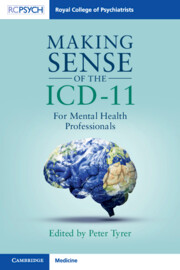Book contents
- Making Sense of the ICD-11
- Making Sense of the ICD-11
- Copyright page
- Contents
- Contributors
- Introduction
- Chapter 1 Development and Innovation in the ICD-11 Chapter on Mental, Behavioural and Neurodevelopmental Disorders
- Chapter 2 ICD-11 + DSM-5 = A Diagnostic Babel
- Chapter 3 Schizophrenia or Other Primary Psychotic Disorders
- Chapter 4 Mood Disorders
- Chapter 5 Disorders Specifically Associated with Stress
- Chapter 6 Disorders Due to Substance Use
- Chapter 7 Child and Adolescent Psychiatric Disorders
- Chapter 8 Anxiety and Fear-Related Disorders and Obsessive–Compulsive and Related Disorders
- Chapter 9 Personality Disorders
- Chapter 10 Disorders of Intellectual Development
- Chapter 11 Eating Disorders
- Chapter 12 Mental Health Classifications in Primary Care
- Index
- References
Chapter 12 - Mental Health Classifications in Primary Care
Published online by Cambridge University Press: 13 October 2023
- Making Sense of the ICD-11
- Making Sense of the ICD-11
- Copyright page
- Contents
- Contributors
- Introduction
- Chapter 1 Development and Innovation in the ICD-11 Chapter on Mental, Behavioural and Neurodevelopmental Disorders
- Chapter 2 ICD-11 + DSM-5 = A Diagnostic Babel
- Chapter 3 Schizophrenia or Other Primary Psychotic Disorders
- Chapter 4 Mood Disorders
- Chapter 5 Disorders Specifically Associated with Stress
- Chapter 6 Disorders Due to Substance Use
- Chapter 7 Child and Adolescent Psychiatric Disorders
- Chapter 8 Anxiety and Fear-Related Disorders and Obsessive–Compulsive and Related Disorders
- Chapter 9 Personality Disorders
- Chapter 10 Disorders of Intellectual Development
- Chapter 11 Eating Disorders
- Chapter 12 Mental Health Classifications in Primary Care
- Index
- References
Summary
Primary care practitioners are expected to diagnose and manage common mental health problems. An effective mental health classification for primary care needs to enable differentiation of normality from disease, clarify interactions between mind and body and offer guidance on treatment or referral. Four current options are considered. SNOMED CT is a structured clinical vocabulary embedded in GP electronic record systems: despite widespread use it lacks clarity on disease status and diagnostic precision. DSM-5 is ambiguous on the borders of disease and normality, and takes a cognitive approach towards somatic diagnoses. The 3rd edition of the International Classification for Primary Care (ICPC-3) emerges from the experience of primary care consultations and includes both patient and physician perspectives. ICD-11 for primary care (PHC) is a work in progress: some elements, such as eating disorders, simplify ICD-11 categorizations; others, such as anxious depression and bodily stress syndrome, differ from ICD-11. While field trials offer rationales for these differences, uncertainties remain about their diagnostic status and about their impact on the ability of primary care and specialist mental health services to integrate. To enable more effective nosology and integration of care, greater convergence is recommended between ICPC-3 and ICD-11 PHC.
Keywords
- Type
- Chapter
- Information
- Making Sense of the ICD-11For Mental Health Professionals, pp. 137 - 144Publisher: Cambridge University PressPrint publication year: 2023



